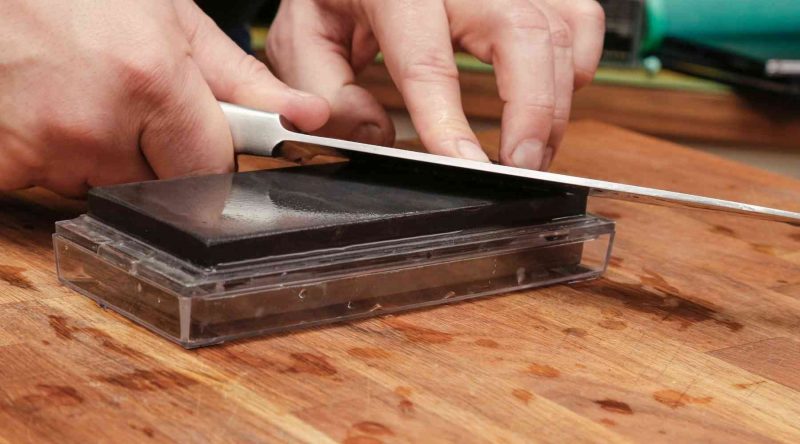If you have a set of serrated knives, you know how useful they can be. A serrated knife has ridges along the blade that allow it to tear and cut more effectively. Serrated knives are often used for tough cuts for things like meat and other things that require a sharp knife blade and serrated edge.
Like any kind of knife, you need to keep that serrated edge in good working condition. Sharpening serrated knives is a bit different than sharpening a straight edge knife because the blade’s edge has tons of blade parts that need to be sharpened.
So we put together this ultimate guide serrated knife sharpening. This guide will cover the types of techniques and tools you need to properly sharpen a serrated knife and how to make sure that your knife will slide smoothly without ruining the serrations.
Sharpening Serrated Knives
Serrated knives are different from other types of knives because they have serrations along the knife blade instead of a perfect same width edge. The serrations give the knife teeth so it can cut and tear through tougher material, like meat or bread. Each of the knife’s serrations need to be sharpened individually and you cannot put the blade into an electric knife sharpener like you can with straight edge knives.
The first thing to realize is that not all serrated knives will be worth sharpening. A cheap micro-serrated knife may not even hold a sharp edge well enough to be worth using a knife sharpener. These kinds of “throwaway” knives can be tossed after they lose their edge. Nice, quality serrated knives like a serrated bread knife or other variants can be sharpened regularly to keep their sharp edge.
The good thing about serrated knives is that they lose their edge slower than straight edge knives. The actual knife blade or a serrated knife does not actually make contact with the cutting board so they usually last longer without having to sharpen them. A high quality serrated knife will also be made from high-grade steel or carbon steel too so it will hold an edge better in general.
Related: Best Boning Knife Reviews
Sharpening vs Honing
We also need to differentiate between sharpening and honing. Honing the blade simply pushes the blade back into the upright position and does not actually create a new edge. On the other hand, actually sharpening a knife removes metal from it to give it a new edge. You should sharpen your blade less frequently than honing as the more that you sharpen, the less able your blade will be able to hold a sharp edge.
Keep in mind that you need different tools for honing a serrated knife and sharpening a serrated knife. Generally, a knife honing tool for stainless steel can be made from stainless steel, but a knife sharpening tool needs to be made from a harder material like a ceramic sharpening rod.
How Often Do I Need to Sharpen My Serrated Knife?
Generally speaking, serrated knives do not need to be sharpened very often. The contact points keep the actual sharp parts off the cutting board so they do not go dull. They are also not used as much as other kinds of knives so they just don’t get as dull as quickly. Also, good serrated blades like a bread knife cat still cut well even if their sharp edges have dulled a bit.
Most serrated knives have a manual that will tell you how often they need to be sharpened. But in general, serrated knives only need to be sharpened about once every 12-24 months. It only takes about 20 minutes to sharpen a serrated knife so a good sharpening will serve you well for a long time.

How to Sharpen a Serrated Knife
If you are familiar with using a knife sharpening for a regular knife, then you know that you need to do a series of long strokes against a sharpening stone for sharpening rod. You then have to reverse and do the same to the other side.
However, serrated knives are different. If you look closely, you can see that there are individual serrations. You can also see that one side has a flat edge while another has little divots, called the beveled edge. You need to sharpen each of those serrated sections in the direction of the beveled edge, not in the direction of the flat edge. That means that you only have to sharpen one side of a serrated blade.
The best thing to use to sharpen a serrated knife is a sharpening rod. A ceramic sharpening rod will work well for a stainless steel blade. Here is how to sharpen a serrated knife blade:
- Hold the serrated knife tip away from your body and angle the beveled serrations slightly up so the blade is not lying flat.
- Put the ceramic sharpening rod into the first scallop. We recommend drawing the blade away from your hands to protect your fingers. Also, you should hold the sharpening rod in your dominant hand and the knife in the opposite hand.
- Do the previous step for each serration. This part will take a while but it’s the only way you can sharpen the entire blade. Each notch needs a few strokes.
- Be careful that you do not sharpen one notch more than others. Notches of different sharpnesses can result in uneven cuts and difficulty slicing.
- After you finish sharpening each notch, turn the blade over onto the flat side. You should be able to feel small pieces of metal (called burrs) that remain partially attached on the flat side of the blade.
- Remove these burrs with the sharpening tool by drawing it over the edge of the knife. You can also use a fine grit sandpaper or a piece of cardboard to remove the burrs.
- After removing the burrs, pass both sides of the knife’s blade over a leather strap. You can also pass each side over a steel honing tool to make sure that the blade is ready to go.
- If your blade requires it, coat it with a finisher of food-safe neutral oil to ensure that it will form an even patina. You only need to oil your knife about once a year.
Overall, sharpening the blade should take you about 20-30 minutes, depending on how fast you go. Remember that you only need to actually sharpen your serrated knife once every year or so, probably even less frequently depending on how often you use it.
To sharpen your serrated knife you can purchase this knife sharpener to make it easy!
How to Hone a Serrated Knife
Most serrated knives do not need to be honed at all because the edge angle does not allow the sharp part to make contact with the cutting board. But, you can still home a serrated blade with the right tools. Follow the instructions above for how to sharpen a serrated knife, but instead, use a steel honing tool. Unlike sharpening, honing a knife only pushes the blade edge back into place so you are not removing blade material from the knife.
The thing is that a serrated knife will still be pretty useful even if you do not hone it regularly. A regular knife needs honing after every few uses but a serrated knife rarely loses its edge unless you intentionally press the edge on the cutting board at the same angle. Even if the perfect edge becomes a bit out of alignment, you can still cut things pretty well with a slightly dull serrated knife because the cutting edge has contact points and teeth.
Related: Best Meat Slicer Reviews
Frequently Asked Questions (FAQs)
Can I sharpen a serrated knife or a serrated electric knife?
Yes, the method we described above will work for sharpening any kind of serrated blade, whether it is electric or not. You can sharpen the blades of a serrated slicer like you would use for brisket or even a small serrated pocket knife.
Can I use an electric knife sharpener tool with serrated knives?
You can use an electric sharpener, but it is not advised. Electric sharpeners are convenient for regular knives but they require a lot of control. It is probably better if you sharpen the individual notches with a sharpening rod rather than an electric sharpener.
Do I have to use a sharpening tool to sharpen a serrated knife?
You should try to buy a special sharpening tool like a rod, but if you don’t have one on hand, there are other options. One potential option is a ceramic coffee mug. Coffee mugs are made from the same kind of material as ceramic sharpening rods so you can use the bottom of a thick mug as a sharpening edge. Just be careful if you try to use a coffee mug.
How can I keep my serrated knife blade sharp longer?
The most effective way to protect your knife edge is to properly store it. Keeping your knife exposed in a drawer can make the blade lose its edge faster than keeping it in a wooden block.
How long does it take to sharpen a serrated knife?
Serrated knives take longer to sharpen than other kinds of knives because you have to make a few passes over the individual curved serrations. The flat edge should give you easy access to the side of the serrated knife so you can sharpen it properly.
Will the knife blade get weaker the more you sharpen it?
Yes. since you are removing material when you sharpen the blade, after a certain point, it will no longer hold an edge properly. That is why you should not over sharpen your blade as this can reduce its operational lifespan.
Is sharpening a serrated knife worth it?
It depends on the kind of knife you have. If you have a high quality high carbon steel knife, you probably can keep the edge longer in general. Cheap knives can often just be thrown away after they lose their edge instead of sharpening them. So if you have a cheap knife, you may just want to toss it when it is done.
Related: Top Butcher Knife Reviews
Final Words on How to Sharpen Serrated Knives
Every kitchen needs a good quality serrated knife. Whether you need it to slice bread, meat, or tough veggies, a serrated knife will serve you well and last a long time. Like any kind of knife, a serrated knife needs to be sharpened regularly, But it does not have to be sharpened as much as a straight-edge blade. As long as you keep a regular routine and maintain your knife, it can last a long time.
